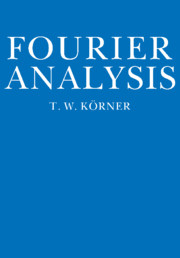Book contents
- Frontmatter
- Miscellaneous Frontmatter
- Contents
- PREFACE
- PART I FOURIER SERIES
- PART II SOME DIFFERENTIAL EQUATIONS
- PART III ORTHOGONAL SERIES
- PART IV FOURIER TRANSFORMS
- Part V FURTHER DEVELOPMENTS
- PART VI OTHER DIRECTIONS
- 91 The future of mathematics viewed from
- 92 Who was Fourier? I
- 93 Who was Fourier? II
- 94 Why do we compute?
- 95 The diameter of stars
- 96 What do we compute?
- 97 Fourier analysis on the roots of unity
- 98 How do we compute?
- 99 How fast can we multiply?
- 100 What makes a good code?
- 101 A little group theory
- 102 A good code?
- 103 A little more group theory
- 104 Fourier analysis on finite Abelian groups
- 105 A formula of Euler
- 106 An idea of Dirichlet
- 107 Primes in some arithmetical progressions
- 108 Extension from real to complex variable
- 109 Primes in general arithmetical progressions
- 110 A word from our founder
- Appendix A The circle T
- Appendix B Continuous function on closed bounded sets
- Appendix C Weakening hypotheses
- Appendix D Ode to a galvanometer
- Appendix E The principle of the argument
- Appendix F chase the constant
- Appendix G Are share prices in Brownian motion?
- Index
101 - A little group theory
Published online by Cambridge University Press: 05 June 2014
- Frontmatter
- Miscellaneous Frontmatter
- Contents
- PREFACE
- PART I FOURIER SERIES
- PART II SOME DIFFERENTIAL EQUATIONS
- PART III ORTHOGONAL SERIES
- PART IV FOURIER TRANSFORMS
- Part V FURTHER DEVELOPMENTS
- PART VI OTHER DIRECTIONS
- 91 The future of mathematics viewed from
- 92 Who was Fourier? I
- 93 Who was Fourier? II
- 94 Why do we compute?
- 95 The diameter of stars
- 96 What do we compute?
- 97 Fourier analysis on the roots of unity
- 98 How do we compute?
- 99 How fast can we multiply?
- 100 What makes a good code?
- 101 A little group theory
- 102 A good code?
- 103 A little more group theory
- 104 Fourier analysis on finite Abelian groups
- 105 A formula of Euler
- 106 An idea of Dirichlet
- 107 Primes in some arithmetical progressions
- 108 Extension from real to complex variable
- 109 Primes in general arithmetical progressions
- 110 A word from our founder
- Appendix A The circle T
- Appendix B Continuous function on closed bounded sets
- Appendix C Weakening hypotheses
- Appendix D Ode to a galvanometer
- Appendix E The principle of the argument
- Appendix F chase the constant
- Appendix G Are share prices in Brownian motion?
- Index
Summary
In previous chapters we looked at some of the uses of the multiplicative group of the nth roots of unity. Under the name of the cyclic group of order n, it furnishes the simplest example of an Abelian group whilst under the name of the additive group of the integers modulo n, it forms a simple but very useful tool in number theory. In this chapter we introduce another kind of Abelian group which also plays an important role in number theory.
Let ℤn be the set of integers mod n. (More formally ℤn is the collection of equivalence classes [a] = {b:b ≡ a mod n}.) Recall that b and c are said to be coprirne if they have no common factors. We make an obvious remark.
Lemma 101.1. (i) if a and n are coprirne so are a + nm and n.
Proof. If q divides n and a + nm then q divides n and a = a + nm – nm.
Thus we can define
G = {[a]∈ℤn:a and n are coprirne}
without ambiguity.
In the same vein we have the following results.
Lemma 101.1. (ii) If [a1] = [a2] and [b1] = [b2] then [a1b1] = [a2b2].
(iii) If [a], [b]∈G then [ab] ∈ G.
Proof. (ii) Since a1 ™ a2, b1 ™ b2 ≡ 0 mod n we have
a1b1 – a2b2 = (a1 – a2)b1 + a2(b1 – b2) ≡ 0 mod n,
as required.
Information
- Type
- Chapter
- Information
- Fourier Analysis , pp. 506 - 508Publisher: Cambridge University PressPrint publication year: 1988
